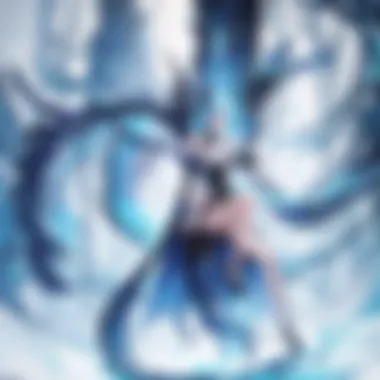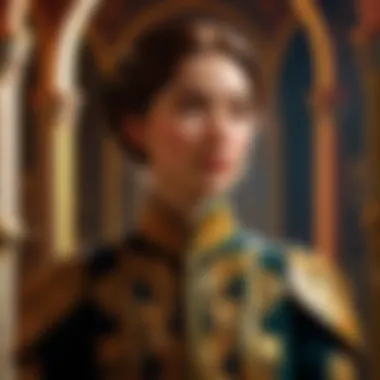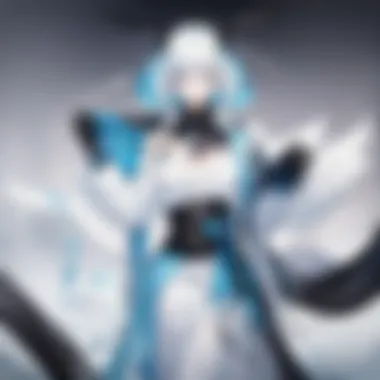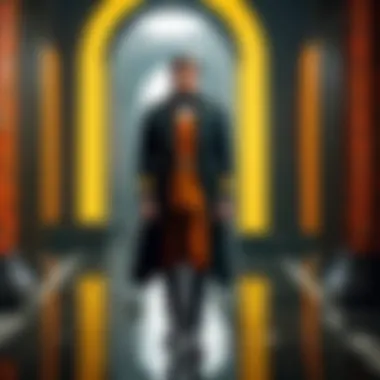Exploring Kmpfer: Gender Identity and Growth in Anime


Intro
The realm of anime is a kaleidoscope of stories, where narratives unfold, characters evolve, and themes resonate on various levels. One such series that exemplifies this complexity is Kmpfer. This anime doesn’t just entertain; it nudges the viewer into a contemplative space regarding gender identity, personal growth, and the nuances of conflict. These elements are intricately woven together, creating an experience that is as thought-provoking as it is engaging.
In our journey through Kmpfer, we will not merely skim the surface. The aim is to dig deeply into its character dynamics and thematic explorations. For both casual viewers and fervent fans, this guide will serve as a comprehensive roadmap, illuminating the various facets of this anime. From analyzing key characters and understanding their arcs to exploring prevalent themes and cultural contexts, each section will contribute to a greater understanding of why Kmpfer stands out in the vast landscape of contemporary anime.
Let’s dive right into the heart of the matter, beginning with an overview of the series, followed by a closer inspection of its characters and underlying themes.
Preface to Kmpfer
Understanding Kmpfer is essential, as it stands out in the crowded landscape of anime with its unique approach to themes of gender identity and conflict. This series goes beyond mere entertainment; it triggers discussions about the complexities of personal identity and the societal norms surrounding it. The narrative is interwoven with various character arcs that showcase struggles and growth, making it a rich subject for analysis. Exploring this series invites viewers into a world that melds fantastical elements with profound social commentary, enriching the experience of both casual fans and serious watchers.
Overview of the Series
Kmpfer revolves around a young man named Natsuru Senou who unexpectedly finds himself at the center of a fantastical conflict. One standout element of the storyline is the transformation he undergoes, shifting from a typical high school student to a girl due to mysterious forces at play. This twist not only serves as a significant plot device but also opens the door to exploration of gender fluidity, identity, and societal expectations.
The series is structured around various "Kmpfer"—these characters are imbued with unique powers and tasked with battling one another. The competition is not just physical; it’s layered with emotional and psychological challenges that bring depth to each character’s journey. Through its blend of action, humor, and serious themes, Kmpfer captivates its audience, delivering moments that are thought-provoking yet enjoyable.
Cultural Context and Reception
Kmpfer first appeared in 2009 as a light novel series, later adapted into an anime that quickly garnered attention. Its release coincided with an increasing awareness of gender issues in pop culture. Though it received mixed reviews, many praised its bold take on gender roles and identity, viewing it as ahead of its time. Some fans appreciated how the series portrayed the struggles and triumphs of its characters, while others critiqued certain narrative choices as lacking depth.
In Japan, Kmpfer became a part of the larger conversation surrounding anime's role in reflecting societal issues. As diverse representation gains traction in media, Kmpfer’s attempts to tackle complex topics resonate with audiences and provoke conversations surrounding acceptance and identity.
"Kmpfer paves the way for discussions about gender identity within anime, challenging norms and encouraging self-exploration."
The series has maintained a steady fanbase, with various online communities dissecting its themes and character dynamics. This ongoing engagement is a testament to Kmpfer's lasting impact, ensuring that discussions around its narrative and implications continue to thrive in forums and social media platforms such as Reddit and Facebook.
Overall, Kmpfer is more than just a show; it's a cultural artifact that invites viewers to reflect on their own identities and societal structures, thereby earning its place in the canon of significant anime works.
Narrative Structure
In the realm of Kmpfer, the narrative structure acts as the backbone of the series, lending coherence and engaging the audience. It’s more than just a sequence of events; it's a complex web that ties characters, themes, and emotions to create a rich tapestry. Understanding how the narrative is woven helps viewers grasp the nuances of the plot and the evolution of each character.
A critical aspect of narrative structure in Kmpfer is its multilayered storytelling. The plot starts with a seemingly unusual premise—normal high school boys turned into girls, leading to misunderstandings, conflicts, and personal growth. This transformation is not merely a gimmick; it serves to explore deeper themes of identity and acceptance. The back-and-forth between different character perspectives adds depth, allowing viewers to appreciate the diverse interpretations of gender roles and societal expectations.
Benefits of Narrative Structure
- Character Development: The way the narrative unfolds provides ample opportunity for character arcs to develop. Each character's journey is influenced by the twists and turns of the plot, leading to a more immersive experience.
- Thematic Exploration: The narrative structure allows for complex themes, such as identity and conflict, to be explored in a layered manner. Instead of presenting these themes in a linear fashion, they emerge through interactions, adding richness to the storytelling.
- Engagement: By utilizing cliffhangers and surprises, the series keeps viewers on their toes. This unpredictability encourages deeper engagement with the storyline as audiences anticipate the next turns.
In essence, the narrative structure is the lens through which one views the entire series. Understanding it enhances the enjoyment and appreciation of Kmpfer's unique approach to interconnected themes and character dynamics.
Plot Synopsis
Kmpfer opens with Natsuru Senou, a typical high school boy, who suddenly finds himself transformed into a girl, thrust into a bewildering situation involving battles that dictate his new existence. As Natsuru grapples with this change, he learns that he is now part of a faction of people known as "Kmpfer," each possessing unique abilities. The show kicks off with high-paced action and humor, leading to deeper explorations of relationships and identity.


Throughout the series, Natsuru faces opponents both in physical confrontations and in interpersonal dynamics, particularly with fellow Kmpfer members. These battles aren't just physical; they metaphorically mirror Natsuru's internal struggles with his new identity. The plot thickens as friendships are tested and rivalries evolve, forcing characters to confront their biases and beliefs about gender and identity.
Character Arcs
Character arcs are perhaps one of the strongest elements of Kmpfer, illustrating profound transformations that resonate with the audience on multiple levels. Natsuru Senou, the protagonist, embodies the struggle of reconciling a new identity with his previous self. His journey from confusion and frustration to self-acceptance is what grounds viewers in the narrative.
Other characters, such as the intense and determined Shizuku Sangou and the cryptic Akane Toudou, also showcase transformative arcs. Each character reflects unique aspects of gender identity, navigating through personal challenges while grappling with societal expectations. Their interactions contribute significantly towards the narrative’s exploration of identity, creating a multifaceted dialogue that resonates with audiences.
Character Analysis
A thorough examination of the character dynamics in Kmpfer reveals the heartbeat of the story, where every twist and turn is intricately tied to the motivations and conflicts of the characters. Analyzing characters in this series isn't merely an exercise in identifying traits or backgrounds; it's about peeling back layers to understand how identity, relationships, and personal growth play out in a fantastical landscape. This analysis helps anchor the story’s thematic explorations, allowing viewers to connect more deeply with the narrative. Each character becomes a mirror reflecting various aspects of the human experience, making their journey relatable and insightful.
Protagonists and Their Motivations
In Kmpfer, protagonists are not just vehicles for plot progression; they embody the core themes of identity and conflict. Take the main character, Natsuru Senou, for instance. His transformation into a female persona triggers a cascade of challenges that force him to confront both societal norms and personal identity. Natsuru's motivations hinge on understanding himself amid chaos—his struggle resonates with viewers who have grappled with their identity.
The overarching aims of these main characters often revolve around self-discovery and the desire to fit into a world that seems determined to judge from the outside. For instance, as Natsuru navigates his dual existence, we see themes of vulnerability and resilience emerge, painting a portrait of someone caught between expectation and personal truth. His journey gives a profound insight into the societal pressure surrounding gender roles, making the viewer ponder their own understanding of identity.
Beyond mere survival or romantic inclinations, protagonists like Natsuru are tasked with confronting larger questions about existence and acceptance. Through their eyes, we witness the clashing of ideals and the bending of rules that govern their world.
Antagonists and Their Role
Antagonists in Kmpfer exist not just as obstacles for the protagonists but as challenging forces that further illuminate the themes and conflicts within the narrative. Characters such as the enigmatic Akane Mishima serve as catalysts in Natsuru's journey, embodying the contrasting ideals that question the status quo. Akane's motivations often stem from a blend of personal ambition and misunderstood intentions, presenting a rich exploration of the struggle for control.
Instead of simply opposing the protagonist, the antagonists reveal deeper societal implications. They force the protagonists to confront their fears and insecurities head-on. Akane's interactions with Natsuru, laden with conflict, express the complexity of competition rooted in both power dynamics and emotional ties. This creates a space not just for conflict, but for overarching questions about morality, ambition, and the nature of competition itself.
Moreover, the presence of conflicting forces illustrates the multifaceted nature of identity. The clashes create impactful moments that challenge characters and audiences alike to consider their perspectives. Through them, the narrative explores how antagonistic figures can be reflective of internal struggles just as much as they are external opponents.
"In Kmpfer, the boundaries between protagonist and antagonist blur, engaging audiences to think more critically about their own perceptions of good and evil."
Themes Explored in Kmpfer
Understanding the themes that surface throughout Kmpfer offers a clearer view into the fabric of the series. This anime doesn't merely present a narrative; it weaves a rich tapestry of ideas, posing questions about identity, resilience, and societal dynamics. Analyzing these themes can deepen the appreciation for both casual viewers and critical followers of anime.
Identity and Transformation
At the core of Kmpfer is the intricate exploration of identity and personal transformation. The series places characters in situations where their identities evolve, often triggered by unexpected circumstances. For example, the protagonist’s change into a female persona compels them to confront preconceived notions about gender roles and personal perception. This transformation isn't just superficial; it goes hand in hand with their growth, pushing characters toward introspection.
Characters must navigate not only their new identities but also the different expectations that come with them. This transition can resonate with viewers on a personal level, as many struggle with aspects of their identity in various forms. The narrative prompts reflection on how identity can reshape one's relationships, aspirations, and self-awareness.
"Kmpfer demonstrates that identity can be a fluid concept, evolving in the face of challenges and experiences."
Conflict and Resolution
Conflict in Kmpfer serves as the catalyst for character development and thematic exploration. The series presents various forms of conflict, from internal struggles with personal identity to external clashes between opposing forces. Each character’s journey is steeped in conflict, which compels them to face their fears and forge meaningful connections with others.


The resolution of these conflicts is not always straightforward. Rather, it reflects the multifaceted nature of human experiences. Characters learn that resolution doesn't equate to a neat ending; it reflects navigating the complexities of emotions and relationships. This portrayal emphasizes that growth and understanding often come from the most tumultuous of experiences.
Societal Implications
Kmpfer offers a lens through which societal norms can be examined critically. By placing characters in fantastical yet relatable scenarios, the series sheds light on pressing issues like gender identity and societal expectations. It reflects broader cultural conversations surrounding acceptance and the impact of societal pressures on individual choices.
The impact of these themes isn't limited to the narrative; they extend into the anime community at large. Fans engage in discussions that challenge conventional views and promote acceptance and understanding—values that are increasingly vital in today's social climate. In this regard, Kmpfer not only serves as entertainment but as a platform that prompts dialogue about identity, conflict, and societal implications, making it a noteworthy piece in contemporary anime culture.
Artistic Elements
In the context of Kmpfer, artistic elements play a crucial role in not just establishing the series' aesthetic appeal but also in enhancing narrative themes and character development. The unique blend of visual style, animation techniques, and sound design crafts an immersive experience that engages viewers on multiple levels. Thus, a thorough understanding of these artistic components reveals much about the series’ broader implications and contributions to the anime landscape.
Visual Style and Animation Techniques
The visual style of Kmpfer is not merely decorative; it carries weight in relation to the storytelling. Bright colors, flamboyant character designs, and vivid backdrops create a vibrant atmosphere that aligns well with the series’ themes of transformation and identity. Each character, adorned with distinctive traits, reflects their personalities and inner conflicts. For instance, the stark contrast in color palettes used for protagonists and antagonists intensifies the battle between good and evil, pulling viewers deeper into the narrative's emotional core.
Animation techniques employed in Kmpfer further enhance this experience. Fluid movements during key fight scenes emphasize action and urgency, while slower, more calculated animations during dialogue-oriented segments allow the viewer to absorb character motivations and emotional nuances. Techniques like limited animation are used intentionally to maintain focus on critical moments, allowing the expressions and subtle body language of the characters to take center stage.
The choice of animation methods reinforces the duality of characters, bridging the worlds of reality and fantasy while making broader comments on identity and personal growth.
Sound Design and Score
Equally important is the sound design and musical score that accompanies Kmpfer's visuals. The aural landscape complements the narrative arc, creating an atmosphere that resonates with the viewer. The use of sound effects during action sequences punctuates the excitement, while silence at pivotal moments conveys tension, leaving audiences at the edge of their seats.
The musical score, which combines whimsical themes with more serious undertones, plays a significant role in establishing mood. For instance, upbeat tracks during comedic exchanges contrast sharply with somber melodies in more intense and emotional scenarios. This juxtaposition captivates the audience, invoking a range of emotions which keep the viewing experience dynamic and layered.
Additionally, voice acting brings characters to life, with voice actors delivering nuanced performances that add depth to the personalities portrayed. This interplay of visuals, sound, and characters creates a synergistic effect that defines Kmpfer��’s artistic contribution.
Together, these elements—visual style, animation techniques, and sound design—form the backbone of the series’ immersive quality. They not only entertain but also invite the audience to reflect on the underlying themes of identity, conflict, and personal growth present throughout Kmpfer.
Comparative Analyses
The significance of conducting comparative analyses within an examination of Kmpfer lies in the ability to better appreciate the nuances of its storytelling, character development, and thematic depth relative to other works. Such assessments can illuminate the unique attributes of Kmpfer, making it easier to spot both its strengths and potential shortcomings when placed alongside its peers. This comparative lens provides readers and viewers alike a well-rounded perspective tailored to both seasoned enthusiasts and curious newcomers.
Kmpfer in Relation to Other Anime
When juxtaposed with other anime series, Kmpfer occupies a curious place on the spectrum of character-driven narratives. It can be readily compared to shows that explore similar themes, such as Ouran High School Host Club and Yamato Nadeshiko Shichi Henge. Both series feature a blend of comedy and drama, showcasing gender identity in fantastical scenarios.
For instance, both Kmpfer and Ouran High School Host Club utilize humor to navigate complex social interactions. However, while Ouran adopts a more lighthearted tone, Kmpfer delves into the darker corners of adolescence and identity. The disparity lies not just in tone but in how these narratives utilize fantastical elements to engage with reality.
One striking aspect is how characters in Kmpfer, much like those in Re:Creators, grapple with the surreal consequences of their identities. Where Re:Creators projects fictional characters into the real world, Kmpfer twists the identity dynamics through a magical-transformation lens, presenting challenges that resonate with youth struggling with gender norms. The metamorphosis of characters into their alter egos raises questions about authenticity and self-perception.
"By comparing Kmpfer with similar shows, we reveal layers of meaning that might otherwise go unnoticed, providing a richer context for understanding its impact." - Anime Enthusiast, October 2023
Influence on Subsequent Works


*After its debut, Kmpfer has distinctly influenced the trajectory of anime that tackles gender fluidity and identity crises. Subsequent series have drawn inspiration from its blending of typical tropes with groundbreaking themes. For example, shows like Bungou Stray Dogs and Yuri!!! on ICE have emerged, where characters often navigate shifting identities and confront societal expectations.
The narrative style of Kmpfer especially echoes through these works. The ways in which character development transpires—intertwined with conflicting relationships and challenges—has paved roads for future storytelling. In landscape saturated with hybrid genres, Kmpfer's unique stance on gender and character transformation opened doors to a more expansive exploration of identity in anime.
Moreover, the reception and contextual placement of any anime now are often debated against the backdrop established by earlier series, including Kmpfer. The dialogues surrounding character arcs, often centered on social norms, find echoing tone in later productions that don’t shy away from presenting deep-seated issues, showcasing a gradual shift in audience expectation and acceptance.
As such, Kmpfer stands as a testament that transformation isn’t merely a narrative device; instead, it serves as a lens through which viewers might better understand complexities of themselves and society.
Choosing to analyze Kmpfer comparatively helps frame its cultural implications and the lasting effects it has had on the anime landscape.
Audience Reception and Impact
Understanding audience reception and overall impact is vital in evaluating Kmpfer, especially given its unique narrative and thematic concerns. The response from viewers sheds light on not just their preferences but also how Kmpfer has shaped discussions surrounding gender identity and societal issues within the anime community. This section will explore the nuances of critical acclaim and criticism as well as delve into the vibrant fan reactions that characterize the ongoing engagement with the series.
Critical Acclaim and Criticism
Kmpfer has stirred quite a pot since its debut, earning a mixture of both praise and criticism from anime critics and fans alike. On one hand, many have lauded the series for its bold approach to gender identity. Critics have noted how the plot weaves complex social themes into a fantastical premise, allowing for explosive character developments. Positive commentary often highlights the creativity involved in the narrative's construction. For instance, the way it tackles themes of transformation resonates strongly, giving voice to topics that are often stigmatized.
Yet, on the other hand, some critiques surface around the execution of these themes. A number of viewers find fault with the pacing, arguing that certain aspects of plot development feel rushed. Some reactions pinpoint specific episodes where character motivations may not be fully fleshed out, leading to frustration among the audience. Individual reviews on platforms like reddit.com discuss these themes extensively, often revealing a divide in how the message is received.
"Kmpfer excels in sheer ambition but falters in pacing. It's a mixed bag that has sparked vital conversations."
Critics often share their insights through various forums, creating a robust dialogue around the anime's strengths and shortcomings. This very discourse enriches the experience for both new viewers and dedicated fans, encouraging varied interpretation of the series.
Fan Reactions and Community Engagement
The fan base surrounding Kmpfer tends to be quite vocal and engaged, amplifying its impact far beyond just viewership numbers. The anime's unique narrative combined with its exploration of gender identity resonates with many, leading to fervent discussions on social media and within dedicated fan circles.
Communities have formed on platforms like facebook.com and specialized fan forums where viewers express their thoughts and analyses. Many fans appreciate the character depth, often sharing fan art, fan fiction, and engaging in spirited debates about character motives and development.
Some fans view Kmpfer as a beacon of representation, seeing their experiences reflected in its themes. This sense of community cultivates a supportive environment where individuals can express themselves freely, reinforcing the series' cultural significance. However, there are also criticisms from sections of the fandom regarding portrayals that may appear stereotypical or overly simplistic.
- Active fan events:
- Virtual watch parties
- Character analysis discussions
- Artwork sharing and feedback
Ultimately, the reactions of fans towards Kmpfer showcase how powerful the series is as a conversation starter—sparking dialogue not just about the show, but broader societal questions as well. The intersection of criticism and acclaim within the fan community is a testament to the series' complexity and the various ways it has touched its audience.
Closure
The conclusion of this exploration into Kmpfer is crucial as it weaves together various threads discussed throughout the article, laying bare the series' multifaceted legacy. In a world awash with superficial narratives, Kmpfer stands out for its audacious probing into gender identity and the complications that arise in personal relationships. By diving into these complex themes, the series invites audiences to consider their own understandings of identity, thus fostering a deeper dialogue around societal norms.
Final Thoughts on Kmpfer's Legacy
Kmpfer's legacy is not merely about its premise; it's about how it has carved out space for conversations on previously unaddressed matters, particularly for individuals grappling with their identities. The multilayered characters serve as avatars of various struggles, reflecting both the external pressures of society and the internal conflicts faced during the journey of self-acceptance. These portrayals invoke empathy and acknowledgement, urging viewers to recognize their own truths.
Additionally, the series has generated a wave of discourse in the anime community, empowering fans to share personal experiences that resonate with Kmpfer's themes. From spirited debates in online forums like reddit.com to profound conversations on platforms like facebook.com, Kmpfer has transcended entertainment; it has become a catalyst for change in how gender identity is perceived within the realm of anime.
Future Directions for Similar Works
Looking forward, the success of Kmpfer may very well encourage creators to explore unconventional narratives that delve into societal issues. The industry has begun to showcase anime that challenge traditional story arcs and character development. Future productions could take inspiration from Kmpfer by infusing elements of reality into fantastical settings, offering space for viewers to reflect on their own lives.
Moreover, there is a growing demand for series that not only entertain but also speak to the pressures of modern life and gender expressions. By continuing to push boundaries, new releases might invoke complexities similar to those seen in Kmpfer, extending beyond basic tropes and revealing deeper human experiences.



